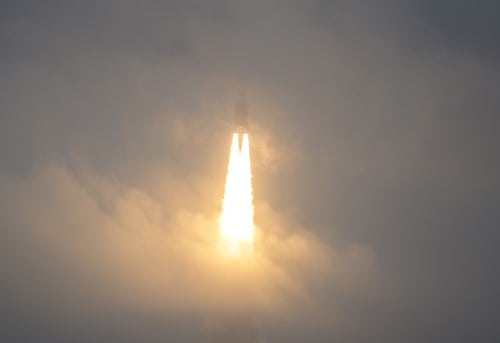NASA has successfully launched its much anticipated $10bn James Webb Space Telescope (JWST). The mission took off today aboard an Ariane 5 rocket from the European Spaceport located near Kourou, French Guiana, at 12:20 GMT. It will now make its way to Lagrange point L2 – a place in space some 1.5 x 106 km away from the Earth in the exact opposite direction from the Sun.
First mooted in the late 1990s as the Next Generation Space Telescope, the craft was initially pegged for launch in 2007 at a cost of $1bn. Yet the mission, which was renamed in 2002 after a former NASA administrator, has been beset by delays and cost overruns. Indeed, on several occasions US Congress had to grant NASA more funds to continue its progress towards launch.
The JWST was set to take off in March but that was postponed to October due to the impact of the COVID-19 pandemic. NASA then pushed it back to 18 December, but that was delayed twice in December near launch– the first time when the unplanned release of a clamp band caused a vibration through the observatory that warranted investigation, while on 14 December NASA announced that the craft would not launch before 24 December due to the discovery of a “communications issue” between the observatory and the launch vehicle system.
On 16 December, Thomas Zurbuchen, NASA’s associate administrator for the science mission directorate, took to Twitter to confirm that the communication issue had been fixed and the JWST was undergoing final “aliveness” tests.
Now that the observatory has finally got off the ground, astronomers will be hoping that once it arrives at L2, the fraught 30-day period when the 6.5 m primary mirror is unpacked and the tennis-court-sized sunshield unfurls go without incidence.

The ten-billion-dollar gamble: What the JWST will do (and why it’s taken so long)
If all goes well, then the JWST is set to revolutionize astronomy peering back some 300 million years after the Big Bang when some of the first galaxies existed. It will also probe the atmospheres of the planets as they pass between the telescope and their parent stars. It will so via four main scientific instruments, which include spectrographs, imagers and infra-red cameras.
“The James Webb Space Telescope represents the ambition that NASA and our partners maintain to propel us forward into the future,” says NASA administrator Bill Nelson. “The promise of Webb is not what we know we will discover; it’s what we don’t yet understand or can’t yet fathom about our Universe. I can’t wait to see what it uncovers!”
